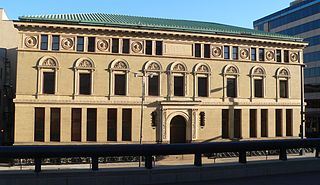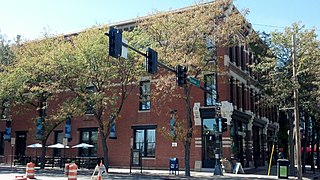
The Drake Court Apartments and the Dartmore Apartments Historic District, built between 1916 and 1921, is located at Jones Street from 20th to 23rd Streets in Midtown Omaha, in the U.S. state of Nebraska. Built in combined Georgian Revival, Colonial Revival and Prairie School styles, the complex was designated a City of Omaha Landmark in 1978; it was listed on the National Register of Historic Places as a historic district in 1980. The historic district originally included 6.5 acres (2.6 ha) with 19 buildings. In 2014, boundary of the historic district was expanded by 0.74 acres (0.30 ha) include three additional buildings, and decreased by 3 acres (1.2 ha) to remove open space and parking that had been re-purposed, for a new total of 4.24 acres (1.72 ha). The district was also renamed to Drake Court Historic District.

Calvin Memorial Presbyterian Church, located at 3105 North 24th Street, was formed in 1954 as an integrated congregation in North Omaha, Nebraska. Originally called the North Presbyterian Church, the City of Omaha has reported, "Calvin Memorial Presbyterian Church is architecturally significant to Omaha as a fine example of the Neo-Classical Revival Style of architecture." It was designated a City of Omaha landmark in 1985; it was listed on the National Register of Historic Places as North Presbyterian Church in 1986.

Sacred Heart Catholic Church is located at 2206 Binney Street in the Kountze Place neighborhood of North Omaha, Nebraska within the Roman Catholic Archdiocese of Omaha.

The Sherman is a historically significant apartment building located at 2501 North 16th Street in the Near North Side of Omaha, Nebraska. Built in 1897, it was designated an Omaha landmark in 1985; in 1986 it was listed on the National Register of Historic Places.

Saunders School, located at 415 North 41st Avenue in the Midtown area of Omaha, Nebraska, United States, was declared a landmark by the City of Omaha in 1985, and listed on the National Register of Historic Places in 1986.

The Livestock Exchange Building in Omaha, Nebraska, was built in 1926 at 4920 South 30 Street in South Omaha. It was designed as the centerpiece of the Union Stockyards by architect George Prinz and built by Peter Kiewit and Sons in the Romanesque revival and Northern Italian Renaissance Revival styles. In 1999 it was designated an Omaha Landmark and listed on the National Register of Historic Places. The Union Stockyards were closed in 1999, and the Livestock Exchange Building underwent an extensive renovation over the next several years.

Vinton School was built as a fourteen-room elementary school in 1908 at 2120 Deer Park Boulevard in the Deer Park neighborhood of Omaha, Nebraska, United States. Designed by Omaha architect Frederick W. Clarke, Vinton School is the earliest and most elaborate example of a Tudor Revival-style school in Omaha. Designated an Omaha Landmark in June 1990, the building was listed on the National Register of Historic Places in November 1989.

The original Omaha Public Library building was built in 1891 at 1823 Harney Street in downtown Omaha, Nebraska by renowned architect Thomas Kimball. Designed in the Second Renaissance Revival style, the building was designated an Omaha Landmark in October 1978, and was listed on the National Register of Historic Places that same year.

Park School is located at 1320 South 29th Street in south Omaha, Nebraska, United States. The school was designed by Thomas R. Kimball and built in 1918. It was listed on the National Register of Historic Places in 1989 and designated an Omaha Landmark in 1990.

Mason School is located at 1012 South 24th Street in south Omaha, Nebraska, United States. Designed in the Richardson Romanesque style by the architectural firm of Mendelssohn, Fisher and Lawrie, the school was built in 1888 by the brick manufacturing and construction firm of Hadden, Rocheford & Gould. The school closed in the late 1970s and was converted into apartments. It was designated an Omaha Landmark in 1986 and listed on the National Register of Historic Places that same year.

The Blackstone Hotel is a historic hotel located at 302 South 36th Street in the Blackstone neighborhood of the Midtown area in Omaha, Nebraska. Built in 1915, it was declared an Omaha Landmark in 1983 and listed on the National Register of Historic Places in 1985.

The Rose Blumkin Performing Arts Center or The Rose, also known as the Astro Theater, originally opened as The Riviera. It is located in downtown Omaha, Nebraska. Built in 1926 in a combination of both Moorish and Classical styles, the building was rehabilitated in 1986.

The Center School, now known as the Lincoln School Apartments, is located at 1730 South 11th Street in South Omaha, Nebraska, United States. Built in 1893, it was declared an Omaha Landmark June 18, 1985 and listed on the National Register of Historic Places on August 23, 1985.

The Rosewater School, now known as the Rosewater Apartments, is located in South Omaha, Nebraska, United States. Built in 1910, the building was named an Omaha Landmark on September 18, 1984, and added to the National Register of Historic Places in 1985.

The Robbins School, originally called Franklin School, is located at 4302 South 39th Avenue in South Omaha, Nebraska, United States. It was built in 1910 to serve a newly established and growing Polish community in south Omaha. A 2000 rehabilitation converted the former school to rental residential use.

The Poppleton Block is located at 1001 Farnam Street in Downtown Omaha, Nebraska. The building was built in 1880 for Omaha lawyer and politician A.J. Poppleton, and was designated an Omaha Landmark on July 13, 1982, and was listed on the National Register of Historic Places later that year.
John Latenser Sr. (1858–1936) was an American architect whose influential public works in Omaha, Nebraska, numbered in the dozens. His original name was Johann Laternser.

The Burlington Headquarters Building, also called Burlington Place, is located at 1004 Farnam Street in Downtown Omaha, Nebraska. This four-story brick building was originally designed by Alfred R. Dufrene and built in 1879 next to Jobbers Canyon. It was redesigned by noted Omaha architect Thomas R. Kimball in 1899, and vacated by the railroad in 1966. The building was listed on the National Register of Historic Places in 1974, designated an Omaha Landmark in 1978, and rehabilitated in 1983. Today it is office space.

St. Martin of Tours Episcopal Church is a historic stone Episcopal church building located at 2312 J Street in the South Omaha district of Omaha, Nebraska. Built in 1899 in the Late Gothic Revival style, it was designated an Omaha Landmark and listed on the National Register of Historic Places in 1982. It was the first Episcopal church established in South Omaha when the town was being developed. It is the only surviving Episcopal church in this community, which was settled chiefly by Catholic immigrants.




















